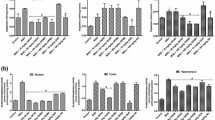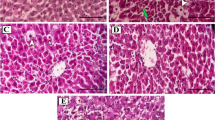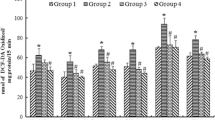Abstract
Syzygium cumini (L.) Skeels (Sc) belongs to the medicinal plants with an important source of phenolic compounds. Sc has been shown to possess antioxidant and anti-inflammatory properties. Methylmercury (MeHg), a highly toxic environmental pollutant, induces oxidative stress and dysfunction in many cell types. This study was aimed to evaluate the effect of aqueous seed extract of Sc (ASc) on MeHg-induced toxicity in rats. Two-day-old rats (P2) received a single dose of MeHg (10 mg/kg) and two doses of ASc (0.9 mg/kg) per os. After two days, the effects of the treatment were investigated in the cerebral cortex, hippocampus, kidney, liver and urine samples. Our results demonstrated that N-acetyl-β-d-glucosaminidase (NAG) activity in the kidney and urine, the lipid peroxidation levels in the liver and kidney samples, as well as the adenosine deaminase (ADA) activity in the hippocampus, kidney and liver were higher in MeHg-group when compared to the control group. The administration of ASc reverted the toxic effects of MeHg. It is noteworthy to observe that the main compounds present in the ASc, as gallic acid (the major component), chlorogenic acid and rutin, might be the responsible for such benefit, since they were found to display antioxidant properties.





Similar content being viewed by others
References
Abbracchio MP, Ceruti S (2007) P1 receptors and cytokine secretion. Purinergic Signal 3:13–25
Abdalla FH, Bellé LP, De Bona KS, Bitencourt PE, Pigatto AS, Moretto MB (2010) Allium sativum L. extract prevents methyl mercury-induced cytotoxicity in peripheral blood leukocytes (LS). Food Chem Toxicol 48:417–421
Bellé LP, De Bona KS, Abdalla FH, Pimentel VC, Pigatto AS, Moretto MB (2009) Comparative evaluation of adenosine deaminase activity in cerebral cortex and hippocampus of young and adult rats: effect of garlic extract (Allium sativum L.) on their susceptibility to heavy metal exposure. Basic Clin Pharmacol Toxicol 104:408–413
Bhat M, Zinjarde SS, Bhargava SY, Kumar AR, Joshi BN (2008) Antidiabetic Indian plants: a good source of potent amylase inhibitors. Evid Based Complement Alternat Med 1–6. doi:10.1093/ecam/nen040
Bosomworth MP, Aparicio SR, Hay AW (1999) Urine N-acetyl-beta-d-glucosaminidase—a marker of tubular damage? Nephrol Dial Transpl 14:620–626
Brito FA, Lima LA, Ramos MF, Nakamura MJ, Cavalher-Machado SC, Siani AC, Henriques MG, Sampaio AL (2007) Pharmacological study of anti-allergic activity of Syzygium cumini (L.) Skeels. Braz J Med Biol Res 40:105–115
Buege JA, Aust SD (1978) Microsomal lipid peroxidation. Method Enzymol 52:302–310
Castoldi AF, Coccini T, Ceccatelli S, Manzo L (2001) Neurotoxicity and molecular effects of methylmercury. Review. Brain Res Bull 55:197–203
Clarkson TW, Strain JJ (2003) Nutritional factors may modify the toxic action of methyl mercury in fish-eating populations. J Nutr 133:1539–1543
Conlon BA, Law WR (2004) Macrophages are a source of extracellular adenosine deaminase-2 during inflammatory responses. Clin Exp Immunol 138:14–20
Damasceno L, Ventura R, Cardoso J, Segura J (2002) Diagnostic evidence for the presence of beta-agonists using two consecutive derivatization procedures and gas chromatography-mass spectrometric analysis. J Chromatogr B Analyt Technol Biomed Life Sci 780:61–71
Desrosiers MD, Cembrola KM, Fakir MJ, Stephens LA, Jama FM, Shameli A, Mehal WZ, Santamaria P, Shi Y (2007) Adenosine deamination sustains dendritic cell activation in inflammation. J Immunol 179:1884–1892
Fredholm BB (2007) Adenosine, an endogenous distress signal, modulates tissue damage and repair. Cell Death Differ 14:1315–1323
Giusti G (1974) Adenosine deaminase. In: Bergmeyer HV (ed) Methods of enzymatic analysis. Academic Press, New York, pp 1092–1099
Gong G, Qin Y, Huang W, Zhou S, Yang X, Li D (2010) Rutin inhibits hydrogen peroxide-induced apoptosis through regulating reactive oxygen species mediated mitochondrial dysfunction pathway in human umbilical vein endothelial cells. Eur J Pharmacol 628:27–35
Horak E, Hopfer SM, Sunderman FW Jr (1981) Spectrophotometric assay for urinary N-acetyl-beta-d-glucosaminidase activity. Clin Chem 27:1180–1185
Jacobson KA, Hoffmann C, Cattabeni F, Abbracchio MP (1999) Adenosine-induced cell death: evidence for receptor-mediated signalling. Apoptosis 4:197–211
Jagetia GC, Baliga MS (2002) Syzygium cumini (Jamun) reduces the radiation-induced DNA damage in the cultured human peripheral blood lymphocytes: a preliminary study. Toxicol Lett 132:19–25
Kavlock RJ, Rogers EH, Rehnberg BF (1981) Renal functional teratogenesis resulting from adriamycin exposure. Teratology 33:213–220
Korkmaz A, Kolankaya D (2009) Protective effect of rutin on the ischemia/reperfusion induced damage in rat kidney. J Surg Res. doi:10.1016/j.jss.2009.03.022
Liu W, Wang X, Zhang R, Zhou Y (2009) Effects of postnatal exposure to methylmercury on spatial learning and memory and brain NMDA receptor mRNA expression in rats. Toxicol Lett 188:230–235
Mahmoud II, Marzouk MAS, Maharram FA, El-Gindi MR, Hassan AMK (2001) Acylated flavonol glycosides from Eugenia jambolana leaves. Phytochemistry 58:1239–1244
Manfroi CB, Schwalm FD, Cereser V, Oliveira L, Rocha JBT, Frizzo MES, Souza DO, Farina M (2004) Maternal milk as methylmercury source for suckling mice: neurotoxic effects involved with the cerebellar glutamatergic system. Toxicol Sci 81:172–178
Moresco RN, Sperotto RL, Bernardi AS, Cardoso RF, Gomes P (2007) Effect of the aqueous extract of Syzygium cumini on carbon tetrachloride-induced hepatotoxicity in rats. Phytother Res 21:793–795
Moretto MB, Franco J, Posser T, Nogueira CW, Zeni G, Rocha JB (2004) Ebselen protects Ca2+ influx blockage but does not protect glutamate uptake inhibition caused by Hg2+. Neurochem Res 29:1801–1806
Moretto MB, Funchal C, Santos AQ, Gottfried C, Boff B, Zeni G, Pureur RP, Souza DO, Wofchuk S, Rocha JB (2005) Ebselen protects glutamate uptake inhibition caused by methyl mercury but does not by Hg2+. Toxicology 214:57–66
Nordberg GF, Jin T, Wu X, Lu J, Chen L, Lei L, Hong F, Nordberg M (2009) Prevalence of kidney dysfunction in humans––relationship to cadmium dose, metallothionein, immunological and metabolic factors. Biochimie 91:1282–1285
Prince PS, Menon VP, Pari L (1998) Hypoglycemic activity of Syzygium cumini seeds: effect on lipid peroxidation in alloxan diabetic rats. J Ethnopharmacol 61:1–7
Prince PS, Kamalakkannan N, Menon VP (2004) Antidiabetic and antihyperlipidaemic effect of alcoholic Syzigium cumini seeds in alloxan induced diabetic albino rats. J Ethnopharmacol 91:209–213
Ramirez RO, Roa CC Jr (2003) The gastroprotective effect of tannins extracted from duhat (Syzygium cumini Skeels) bark on HCl/ethanol induced gastric mucosal injury in Sprague-Dawley rats. Clin Hemorheol Microcirc 29:253–261
Robic D, Bens M, Loko F, Vandewalle A, Bourbouze R (1995) N-acetyl-β-d-glucosaminidase (NAG) isoenzymes in primary cultures of rabbit kidney proximal tubule cells: a cellular model for studies on nephrotoxicity? Toxicology 103:37–44
Sakamoto M, Kakita A, de Oliveira RB, Sheng Pan H, Takahashi H (2004) Dose-dependent effects of methylmercury administered during neonatal brain spurt in rats. Brain Res Dev Brain Res 152:171–176
Sharma SB, Nasir A, Prabhu KM, Murthy PS, Dev G (2003) Hypoglycaemic and hypolipidemic effect of ethanolic extract of seeds of Eugenia jambolana in alloxan-induced diabetic rabbits. J Ethnopharmacol 85:201–206
Stanley MP, Kamalakkannan N, Menon PV (2003) Syzigyum cumini seed extracts reduce tissue damage in diabetic rat brain. J Ethnopharmacol 84:205–209
Takeuchi T, Eto N, Eto K (1979) Neuropathology of childhood cases of methylmercury poisoning (Minamata disease) with prolonged symptoms, with particular reference to the decortication syndrome. Neurotoxicol 1:1–20
Timbola AK, Szpoganicz B, Branco A, Monache FD, Pizzolatti MG (2002) A new flavonol from leaves of Eugenia jambolana. Fitoterapia 73:174–176
Veigas JM, Shrivasthava R, Neelwarne B (2008) Efficient amelioration of carbon tetrachloride induced toxicity in isolated rat hepatocytes by Syzygium cumini Skeels extract. Toxicol In Vitro 22:1440–1446
Wardas J (2002) Neuroprotective role of adenosine in the CNS. Pol J Pharmacol 54:313–326
Woods JS, Bowers MA, Davis HA (1991) Urinary porphyrin profiles as biomarkers of trace metal exposure and toxicity: studies on urinary porphyrin excretion patterns in rats during prolonged exposure to methyl mercury. Toxicol Appl Pharmacol 110:464–476
Zalups RK, Bridges CC (2009) MRP2 involvement in renal proximal tubular elimination of methylmercury mediated by DMPS or DMSA. Toxicol Appl Pharmacol 235:10–17
Acknowledgments
This study was funded by the Research Foundation of the State of Rio Grande do Sul (FAPERGS – Fundação de Amparo à Pesquisa do Rio Grande do Sul) and supported by the Research and Graduate Provost Office (PRPPG –Pró-Reitoria de Pesquisa - UFSM), Brazil.
Author information
Authors and Affiliations
Corresponding author
Rights and permissions
About this article
Cite this article
Abdalla, F.H., Bellé, L.P., Bitencourt, P.E.R. et al. Protective effects of Syzygium cumini seed extract against methylmercury-induced sistemic toxicity in neonatal rats. Biometals 24, 349–356 (2011). https://doi.org/10.1007/s10534-010-9402-5
Received:
Accepted:
Published:
Issue Date:
DOI: https://doi.org/10.1007/s10534-010-9402-5




